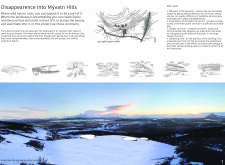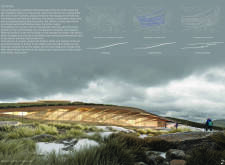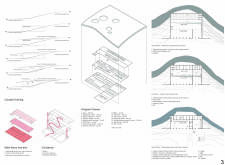5 key facts about this project
The primary function of the project includes public services designed for both local residents and visitors. Spaces are organized to facilitate easy navigation and accessibility, meeting essential needs while fostering connectivity among users. The layout incorporates areas dedicated to educational and research activities, emphasizing the importance of environmental stewardship and community involvement.
Design Principles and Approaches
What differentiates this project from similar architectural endeavors is its focus on blending built forms into the topography without compromising aesthetics or functionality. The design employs a variety of unique elements that enhance user experience while maintaining harmony with the landscape.
The use of green roofs serves both practical and aesthetic purposes, allowing the structure to blend seamlessly with the hillsides. These roofs not only contribute to thermal efficiency but also promote rainwater absorption, aligning with the project's sustainability goals. Expansive glass facades maximize natural light, creating a sense of openness and connectivity with the outdoors. This strategic incorporation of advanced glass glazing reflects the natural surroundings, making the building feel both integrated and unobtrusive.
Another noteworthy aspect of this project's design is its use of recycled organic waste materials, particularly in the areas designated for research and gardening. This innovative approach encourages local engagement with sustainable practices and reinforces the project's ecological commitments. The arrangement of floors responds to the existing topography, resulting in a stratified organization that enhances visibility and accessibility across different levels.
Spatial Organization and User Experience
The interior spaces are carefully planned to support diverse functions, with the first level incorporating community-centric areas that include a multipurpose room and a resource exchange point. The upper levels are dedicated to research facilities and gardening sections, which not only serve the operational needs of the project but also promote a sense of community ownership.
The flow of circulation paths throughout the building is designed to enhance user interaction and experience. Visitors can navigate seamlessly through the spaces, discovering various functional areas interwoven with nature. This design fosters an environment conducive to both individual reflection and community gatherings.
In summary, "Disappearance into Mývatn Hills" represents a thoughtful exploration of architectural design that emphasizes sustainability, community engagement, and integration with the landscape. The project effectively combines various functional elements while maintaining a strong connection to its natural surroundings. Readers are encouraged to explore the project presentation further for a deeper understanding of the architectural plans, sections, designs, and ideas that shape this unique endeavor.

























